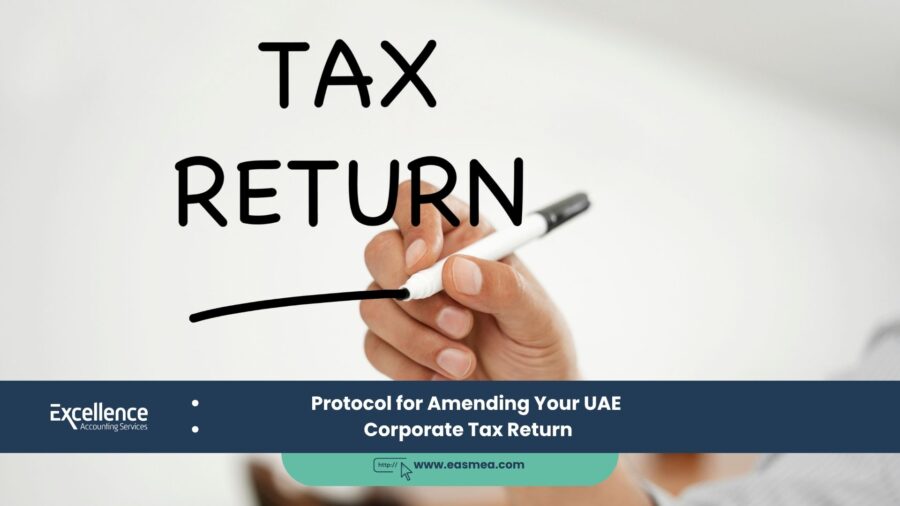Protocol for Amending Your UAE Corporate Tax Return
In a mature tax system, accuracy is paramount. With the introduction of Corporate Tax (CT) in the UAE, businesses are now responsible for ensuring the information submitted to the Federal Tax Authority (FTA) is complete and correct. However, in the complexities of business finance, errors can happen. Discovering a mistake in a filed tax return can be a source of significant anxiety for any business owner. But the UAE’s tax legislation provides a clear and structured pathway for rectification: the Voluntary Disclosure.
- Protocol for Amending Your UAE Corporate Tax Return
- Part 1: Common Triggers - Why Would a Tax Return Need Amending?
- Part 2: The Legal Framework - Understanding Voluntary Disclosure
- Part 3: The Step-by-Step Protocol for Filing a Voluntary Disclosure
- Part 4: The Role of Technology in Preventing Errors
- How Excellence Accounting Services (EAS) Can Help
- Frequently Asked Questions (FAQs)
- Discovered an Error in Your Tax Return?
Far from being a sign of failure, the protocol for amending a tax return is a feature of a transparent and fair tax environment. It allows conscientious taxpayers to correct inaccuracies, regularize their tax position, and mitigate potentially severe penalties. Understanding this process is not just about fixing mistakes; it’s about embedding a culture of robust compliance and maintaining a relationship of trust with the tax authority. This guide provides a comprehensive, step-by-step protocol for businesses on when and how to amend a UAE Corporate Tax return, detailing the legal framework, the practical procedures, and the strategic importance of getting it right.
Key Takeaways on Amending a Tax Return
- Voluntary Disclosure (VD) is the Formal Mechanism: Amending a submitted tax return is done by filing a Voluntary Disclosure form through the EmaraTax portal.
- It’s for Substantive Errors: The process is designed for correcting errors that impact the calculation of your tax liability, not for minor clerical typos.
- Timing is Critical: A VD must be submitted within 20 business days of the taxpayer discovering the error. Prompt action is essential.
- Reduces Penalties: Proactively disclosing and correcting an error can significantly reduce the penalties compared to the FTA discovering the same error during an audit.
- Requires Full Transparency: The VD form requires a detailed explanation of the error, its financial impact, and the corrected tax calculation.
Part 1: Common Triggers – Why Would a Tax Return Need Amending?
The need to amend a tax return can arise from a wide range of situations, almost all of which are unintentional. Recognizing these triggers is the first step in maintaining compliance.
Common Scenarios:
- Calculation Errors: Simple mathematical mistakes in calculating taxable income or the final tax due.
- Omission of Income: Forgetting to include a particular revenue stream, such as income from a one-off project or a specific service line.
- Incorrect Expense Claims: Misclassifying a non-deductible expense as deductible (e.g., claiming 100% of client entertainment instead of the allowable 50%) or claiming personal expenses. This often requires diligent management of accounts payable.
- Changes in Accounting Estimates: A subsequent event reveals that an accounting estimate used in the financial statements (which formed the basis of the tax return) was incorrect.
- Incorrect Application of Law: Misinterpreting a specific provision of the Corporate Tax Law, such as the rules for interest deduction or Transfer Pricing adjustments.
- Newly Discovered Information: Finding invoices or financial records that were misplaced or unavailable at the time of the original filing. A thorough accounting review can often uncover such items.
The underlying principle is whether the error resulted in an incorrect calculation of the tax payable. If the tax reported to the FTA was less than what it should have been, a Voluntary Disclosure is mandatory.
Part 2: The Legal Framework – Understanding Voluntary Disclosure
The legal basis for amending a tax return is found in the Tax Procedures Law. It provides taxpayers with a formal, structured process to correct errors and omissions in their tax returns, assessments, or refund applications. The FTA encourages taxpayers to come forward proactively, and the penalty regime is designed to be more lenient for those who do.
A Voluntary Disclosure is a formal declaration to the FTA that a previously submitted document contained an error. It serves two main purposes:
- To Correct the Record: It ensures the taxpayer’s record with the FTA is accurate and that the correct amount of tax is ultimately paid.
- To Mitigate Penalties: By self-disclosing, the taxpayer demonstrates good faith and a commitment to compliance, which typically results in lower penalties than if the FTA discovers the error independently through an audit.
Part 3: The Step-by-Step Protocol for Filing a Voluntary Disclosure
Amending your tax return is a formal process that requires care and precision. Follow these steps methodically.
Step 1: Identify, Investigate, and Quantify the Error
This is the most critical phase. As soon as you suspect an error, you must conduct a thorough internal investigation. This involves reviewing your accounting records, source documents, and the calculations used in the original tax return. The goal is to understand the exact nature of the error, the tax periods it affects, and its precise financial impact. For complex situations, engaging a third party for an internal audit or a specific review is highly advisable.
Step 2: Determine the Tax Impact (Underpayment or Overpayment)
Recalculate your taxable income and the final tax liability for the affected period. This will determine if the error led to:
- A Tax Underpayment: You paid less tax than you should have. A VD is mandatory, and you will need to pay the difference plus any applicable penalties.
- A Tax Overpayment: You paid more tax than you were liable for. You can submit a VD to claim a refund for the excess amount.
Step 3: Prepare the Voluntary Disclosure Submission
The VD is filed using a specific form on the FTA’s EmaraTax portal. You will need to provide:
- Your Tax Registration Number (TRN).
- The relevant tax period of the original return being corrected.
- A detailed and transparent description of the error(s). Be clear, concise, and honest. Explain how the error occurred and how it was discovered.
- The corrected figures and the revised tax calculation, clearly showing the difference in the tax amount.
- Supporting documents, if necessary, to substantiate your correction.
Step 4: Submit the Form and Pay the Due Amount
Once the form is completed, submit it electronically via the portal. If your VD results in additional tax being due, you must pay this amount. The FTA will typically not process the VD until the outstanding tax liability has been settled. Penalties associated with the error will be assessed separately by the FTA after the VD is reviewed.
Step 5: Await FTA Review and Communication
After submission, the FTA will review your disclosure. They may:
- Accept the VD as submitted.
- Request further information or clarification.
- Decide to conduct a more detailed examination or a full tax audit if the disclosure is complex or raises other concerns.
Maintaining open communication and responding promptly to any FTA queries is crucial during this stage. Expert representation from a service like ours can be invaluable here.
Part 4: The Role of Technology in Preventing Errors
The best way to handle errors is to prevent them from happening in the first place. Modern, cloud-based accounting software is an essential tool in achieving this. A robust system minimizes the risk of manual data entry errors, which are a common source of tax return mistakes.
Using a UAE-specific platform like Zoho Books ensures that your financial data is organized, accurate, and readily available. It enables:
- Accurate Expense Categorization: Ensuring expenses are correctly classified for tax deductibility.
- Comprehensive Audit Trails: Every transaction is recorded and traceable, making reviews and investigations straightforward.
- Real-Time Financial Reporting: Generating accurate Profit & Loss statements, which are the basis for the tax return, is simplified. A solid system makes services like account reconciliation services more efficient.
A proper accounting system implementation is a foundational investment in tax compliance.
How Excellence Accounting Services (EAS) Can Help
Navigating a tax return amendment requires technical expertise and careful handling. EAS provides end-to-end support to ensure the process is managed correctly and efficiently, minimizing stress and potential penalties.
- Tax Return Health Check: Before you even file, we can conduct a thorough review of your tax calculations and supporting documents to identify and correct potential errors, reducing the likelihood of needing a future VD.
- Error Investigation and Quantification: If an error is discovered, our team of experts will perform a detailed investigation to understand its root cause and accurately calculate the financial impact.
- Voluntary Disclosure Management: We handle the entire VD process, from preparing the detailed explanation and calculations to submitting the form and all supporting documents through the EmaraTax portal.
- Liaison with the FTA: We act as your official representative, managing all communications with the FTA regarding your VD, answering their queries, and providing any additional information required.
- Strategic Tax Advisory: Our high-level CFO services and business consultancy can help you implement stronger internal controls and processes to prevent future errors.
Frequently Asked Questions (FAQs)
An amendment via Voluntary Disclosure is a proactive step you take to correct a mistake you discovered. A clarification request is reactive; it’s initiated by the FTA when their system flags a potential inconsistency or they have a question about your filed return. Responding to a clarification is mandatory, but it’s not the same as formally amending the return itself.
You should still file a Voluntary Disclosure. The process is the same, but instead of resulting in a payment, your corrected calculation will show that you are due a refund from the FTA. The VD form is the official way to substantiate your claim for that refund.
No. The Voluntary Disclosure mechanism is for errors that impact the calculated tax liability. Minor clerical errors, such as a typo in a descriptive field that has no bearing on the numbers, generally do not require a formal amendment.
The law requires you to notify the FTA by submitting a VD within 20 business days from the date you discovered the error. “Discovery” is generally considered the point at which you have enough information to confirm an error exists and to quantify its impact.
Not necessarily. While it may increase the level of scrutiny on the specific area you have corrected, it does not automatically lead to a full audit. In fact, being transparent and proactive can build trust with the FTA. However, if the error disclosed is very large or indicates systemic issues, the FTA may decide a broader review is warranted.
This is a high-risk strategy. If the FTA discovers the error later through an audit, the penalties will be significantly higher than if you had self-disclosed. This can include fixed penalties for the incorrect return and substantial tax-geared penalties based on the underpaid amount. It can also damage your compliance record and reputation with the authority.
You should prepare all documents that prove the error and substantiate the correction. This could include revised financial statements, updated calculation worksheets, copies of invoices that were previously missed, contracts, or detailed written explanations of the change in accounting treatment.
The underlying principle and mechanism (filing a Voluntary Disclosure form) are the same. Both are done through the EmaraTax portal. However, the specifics of the errors will differ based on the respective laws (e.g., a VAT error might relate to zero-rating vs. standard-rating, while a CT error relates to income or expense recognition).
The penalty regime is designed to be more lenient for voluntary disclosures than for errors found by the FTA. While there are fixed penalties for submitting a VD, their amounts are generally lower. Further reductions may be considered by the FTA on a case-by-case basis, especially if the taxpayer can demonstrate compelling reasons and a strong compliance history.
Yes. As the taxpayer, you hold the ultimate responsibility for the accuracy of your tax return, even if it was prepared and filed by a third-party agent. This is why it is crucial to hire reputable and qualified professionals and to review any return carefully before giving your approval for submission.
Conclusion: Turning Correction into a Compliance Strength
In the new tax landscape of the UAE, perfection is the goal, but correction is a practical reality. The protocol for amending a tax return through Voluntary Disclosure should not be viewed with fear, but as a vital tool for maintaining compliance and integrity. It reflects a commitment to accuracy and transparency. By understanding the process, acting promptly upon discovering an error, and leveraging professional expertise, businesses can navigate corrections smoothly, manage their liabilities effectively, and reinforce their standing as responsible, compliant taxpayers in the UAE economy.




